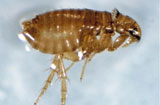Getting Rid of Fleas
There are over 2,000 species of fleas, but the cat flea is the one most likely causing problems for your pet (cat or dog) and in your home.
Fleas are generally only considered nuisances. They mainly cause allergy and dermatological problems for pets and humans; they rarely transmit disease. Pet behavior, such as scratching, can give early detection signs of flea infestations.
Management
To effectively control fleas, you have to remove them from your pet and home—not just the pet alone. In severe infestations, treating outdoor spaces and yards may be necessary. When removing fleas, you want to make sure to remove eggs, developing and adult fleas, as well as flea feces (“flea dirt”), which the larvae feed on.
Pets and homes should be treated at the same time to reduce flea populations.
Pet Treatment
Shampoos
Bathing your pet with soaps, shampoos, or mild detergents drowns fleas and dries out surviving fleas. Shampooing also removes the skin flakes and dried blood that provide food for developing fleas.
Some shampoos contain pesticides, which will have dose-related toxicity. Always consult the label.
*Pennyroyal oil: Some people looking for a natural product may seek out those with pennyroyal oil. The active ingredient in the oil, pulegone, does have a dose related toxicity to mammals. Always use pennyroyal and other essential oils according to label directions and do not create your own concoctions to use on your pet.
Dusts
Dusts are considered safer than shampoos or sprays because they have no solvent to carry pesticide through skin, but dusts have their own problems. Dusts or powders can’t be controlled and can become airborne or ingested by pets during grooming.
If treating with a pyrethrum dust, bathe your pet after treatment to remove the stunned fleas and decrease the risk of your pet ingesting the dust.
Combing
Combs are one option for cats since they usually do not tolerate baths. Drop fleas into soapy water after removing them. Depending on your combing technique, combs will remove 10–60% of the fleas
Topical Treatments
Topical treatments, such as imidaclioprid (Advantage™) and fipronil (Frontline™), are available from veterinarians. These products are pesticides, so always consult the label.
Insect Growth Regulators (IGRs)
IGRs are an effective method for flea control. They work by disrupting normal flea development. (They do not kill adult fleas.) IGRs work at low concentrations and have almost no toxicity. IGRs can be used by themselves if you are willing to wait for them to eliminate flea populations. They usually take about two weeks for noticeable reduction and one to two months for complete control.
Methoprene (Precor) and pyriproxyfen (Nylar, Archer, Biospot) are available in sprays and flea collars. Lufenuron (Program™)—an insect development inhibitor (IDI)—is administered orally to pets.
Home Treatment
Fleas will accumulate in areas where pets rest. Try establishing one sleeping area for your pet and cleaning it regularly. Use bedding that can be washed or thrown away weekly. Exclude pets from areas that are difficult to treat, such as children’s play areas.
Vacuuming will not eliminate flea populations, but will help keep them reduced. Vacuums remove eggs, larvae, adults, and flea dirt, but not pupae, which stick to the carpet fibers. Steam cleaners are usually more effective.
Borax and boric acid can be used on carpet, but may eventually cause damage to carpet fabric or upholstery. Linalool is extract from citrus peels registered for indoor flea control. There are also many insecticidal sprays and aerosols for use on carpet, but they may not be desirable to homeowners uncomfortable with synthetic insecticides.
Outdoor Treatment
If an infestation is severe, yard treatments may be necessary. Sprays and IGRs can be used in dry, shaded areas where pets frequent. Larvae prefer these dry, shaded areas; spraying the entire yard would be wasteful and unnecessary. Simply watering the yard may be enough to reduce flea populations.
Steinernema nematodes have been investigated as a method of biological control of fleas in the yard, though there has not been enough research in Florida to confirm their usefulness.
Ineffective Treatments
Supplementing your pet’s diet with vitamin B, brewer’s yeast, or garlic has not been proven to work. Ultrasonic or insecticidal flea collars also appear to be ineffective.
*A note on flea collars: Flea collars (insecticidal or IGR) are short-term treatments, and should only be used for six days or less. After that time, remove them and store them in a sealed jar until its next use.
Diatomaceous earth usually is unsuccessful in Florida because of the humidity. It also contains silica, which can be harmful if inhaled in excessive amounts.
Flea traps will catch some fleas, but they will not control flea populations. Ultrasonic repelling devices also have been shown to be useless.
Plant materials including fresh wax myrtle leaves, eucalyptus, rosemary, citronella, or cedar chips have not been tested. Dried bayberry leaves have no demonstrated effect on repelling fleas.
Adapted and excerpted from:
D. Zentko and D. Richman, Cat Flea, Ctenocephalides felis felis (EENY-011), Entomology and Nematology Department (rev. 10/2011).
P. Koehler, Reduced Chemical Management of Fleas (ENY-229), Entomology and Nematology Department (rev. 03/2003).

Related Sites & Articles
- Hot Topics
- Bed Bugs
- Biting & Stinging Insects
- UF/IFAS Publications
- Fleas
- UF/IFAS Sites
- Less Toxic Pesticides for Use in Schools and Day Care Centers
- EPA to Require Changes to Pet Spot-On Products

